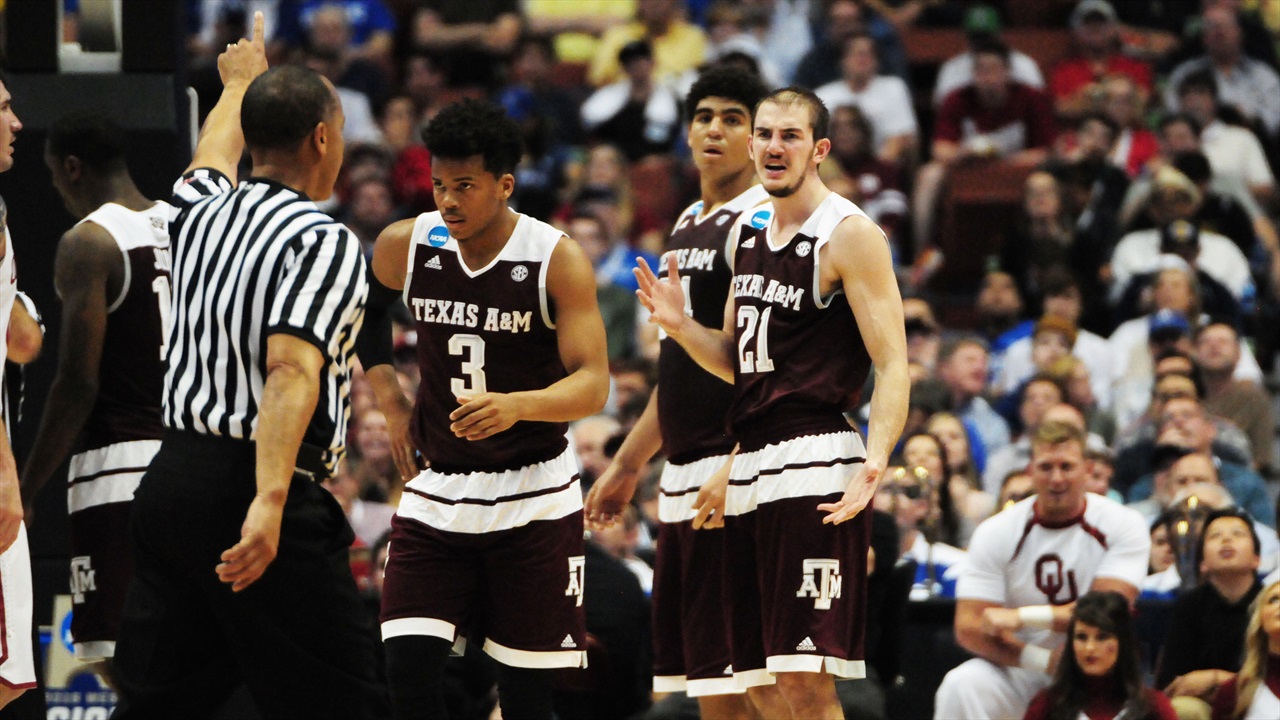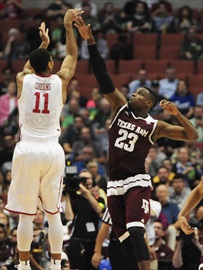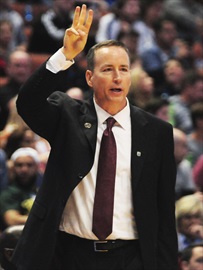
Billy Kennedy
A&M Players
Lon Kruger
Oklahoma Players
Texas A&M Basketball
Poor first half, outside shooting doom Aggies in 77-63 loss to OU
ANAHEIM, Calif. – The question has changed.
Four days ago the prevailing query regarding Texas A&M basketball was: “How did they do that?”
In the aftermath of a 77-63 loss to Oklahoma in the Sweet Sixteen of the NCAA Tournament on Thursday, one wonders: “Why did they do that?”
Why did the Aggies (28-9) routinely settle for three-point shots instead of pounding the basketball inside in a decisive first half?
That decision – and the sporadic perimeter shooting that followed – resulted in the Aggies falling into a deep hole from which they could never climb out.
There would be no miraculous rally this time. The Sooners (28-7) were too accurate and too calm to let a big lead dissolve like Northern Iowa did last Sunday.
The Sooners led 45-26 at halftime and never let the Aggies get closer than 11 points in the second half.
Poor free throw shooting — the Aggies missed eight in a row at one juncture — and Oklahoma’s marksmanship ensured that’s as close as A&M could get.
“You miss the free throws when you have a chance to cut (the lead) under 10,” A&M coach Billy Kennedy lamented. “I thought if we could get it under 10 we could put some pressure on them. I think we had it to 11 with a number of opportunities to make free throws and cut into it."
 Alex Parker, TexAgs
The Aggies challenged one of the nation's best outside shooting teams at its own game and lost.
{"Module":"photo","Alignment":"left","Size":"large","Caption":"The Aggies challenged one of the nation\u0027s best outside shooting teams at its own game and lost.","MediaItemID":69387}
But what if the Aggies had been more diligent in working the ball inside in the first half? Maybe they wouldn’t have been so far behind.
Alex Parker, TexAgs
The Aggies challenged one of the nation's best outside shooting teams at its own game and lost.
{"Module":"photo","Alignment":"left","Size":"large","Caption":"The Aggies challenged one of the nation\u0027s best outside shooting teams at its own game and lost.","MediaItemID":69387}
But what if the Aggies had been more diligent in working the ball inside in the first half? Maybe they wouldn’t have been so far behind.
A&M focused on getting the basketball inside in the second half. Then, Tyler Davis scored 15 points, cutters found their way to the basket and the Aggies drew 13 fouls.
“They’re better defensively than I know after playing them,” Kennedy said. “They’re switching defense, man-to-man and keeping guys out of the lane, force you to shoot threes and if you’re not making shots it makes it tough for you to score. We shot way too many threes today to have a chance to beat them.”
The Aggies hit just four of 14 attempts from 3-point range in the first half. Three of those came in the first four minutes. They eventually hit six of 28 three-pointers. That’s three more attempts than Oklahoma, perhaps the best three-point shooting team in the country, attempted.
Why?
The Aggies didn’t seem to know for sure. Danuel House, who was one-of-five from three-point range, said the Aggies should have gotten the ball inside more. However, he also said the three-point shots were the right decision.
“We didn’t pound it in,” House said. “It was more of us than them. We didn’t force the ball inside. That was it.”
Then he added:
“They were digging a lot on Tyler. He got it and kicked it out. We’ve just got to knock the shots down. We got the right looks. Unfortunately, the ball didn’t go through. The right shots got taken. We were getting it inside and it was coming out. That’s basketball — just trying to find a great read and play off one another.”
The Aggies started fast and held a 15-9 lead six minutes into the game, but OU outscored A&M 36-11 the rest of the half.
A&M’s final lead was 18-15 on a D.J. Hogg three-pointer with 11:54 remaining. The Aggies missed 12 of their next 13 field goal attempts. In one stretch they went seven-and-a-half minutes without a field goal and had just two points in that span.
A&M could not take capitalize on its perceived advantage inside. In fact, OU outscored the Aggies 18-12 in the paint and outrebounded A&M 22-18 in the first half.
“They did a good job of taking me out of my spots, not letting me duck in early and just keeping a guy on my shoulder even when the ball was on the other side of the court,” Davis said. “I should have slowed down a little bit more, but their defense did a good job.”
 Alex Parker, TexAgs
In a theme that was consistent over most of the season, Billy Kennedy's Aggies couldn't get dual strong performances from their two stars.
{"Module":"photo","Alignment":"right","Size":"large","Caption":"In a theme that was consistent over most of the season, Billy Kennedy\u0027s Aggies couldn\u0027t get dual strong performances from their two stars.","MediaItemID":69502}
Frankly, the Sooners’ offense did, too.
Alex Parker, TexAgs
In a theme that was consistent over most of the season, Billy Kennedy's Aggies couldn't get dual strong performances from their two stars.
{"Module":"photo","Alignment":"right","Size":"large","Caption":"In a theme that was consistent over most of the season, Billy Kennedy\u0027s Aggies couldn\u0027t get dual strong performances from their two stars.","MediaItemID":69502}
Frankly, the Sooners’ offense did, too.
High-scoring Buddy Hield was held to 17 points. No big deal. Jordan Woodard compensated with 22 points, while freshman guard Christian James had 12 and forwards Ryan Spangler and Khadeem Lattin had 10 each.
Davis finished with 17, but didn’t get as much help. Jones and House combined to score 21 points, but they also combined to make just seven of 24 shots from the field and three of nine free throw attempts.
For much of season — perhaps since they combined for 48 points in a 71-68 victory over Florida in January — the Aggies were waiting for that game in which Jones and House both played at a high level.
That game never came.
Jones and House played well enough to help A&M post a record 28 wins, reach the Sweet Sixteen for just the fourth time in school history and claim its first conference championship in 30 years.
The Aggies just lost to a better team.
But could the Aggies have been more competitive or even pulled off an upset if they had not settled for three-pointers so often in the first half?
It’s a question worth asking.
Four days ago the prevailing query regarding Texas A&M basketball was: “How did they do that?”
In the aftermath of a 77-63 loss to Oklahoma in the Sweet Sixteen of the NCAA Tournament on Thursday, one wonders: “Why did they do that?”
Why did the Aggies (28-9) routinely settle for three-point shots instead of pounding the basketball inside in a decisive first half?
That decision – and the sporadic perimeter shooting that followed – resulted in the Aggies falling into a deep hole from which they could never climb out.
There would be no miraculous rally this time. The Sooners (28-7) were too accurate and too calm to let a big lead dissolve like Northern Iowa did last Sunday.
The Sooners led 45-26 at halftime and never let the Aggies get closer than 11 points in the second half.
Poor free throw shooting — the Aggies missed eight in a row at one juncture — and Oklahoma’s marksmanship ensured that’s as close as A&M could get.
“You miss the free throws when you have a chance to cut (the lead) under 10,” A&M coach Billy Kennedy lamented. “I thought if we could get it under 10 we could put some pressure on them. I think we had it to 11 with a number of opportunities to make free throws and cut into it."
 Alex Parker, TexAgs
The Aggies challenged one of the nation's best outside shooting teams at its own game and lost.
{"Module":"photo","Alignment":"left","Size":"large","Caption":"The Aggies challenged one of the nation\u0027s best outside shooting teams at its own game and lost.","MediaItemID":69387}
Alex Parker, TexAgs
The Aggies challenged one of the nation's best outside shooting teams at its own game and lost.
{"Module":"photo","Alignment":"left","Size":"large","Caption":"The Aggies challenged one of the nation\u0027s best outside shooting teams at its own game and lost.","MediaItemID":69387}
A&M focused on getting the basketball inside in the second half. Then, Tyler Davis scored 15 points, cutters found their way to the basket and the Aggies drew 13 fouls.
“They’re better defensively than I know after playing them,” Kennedy said. “They’re switching defense, man-to-man and keeping guys out of the lane, force you to shoot threes and if you’re not making shots it makes it tough for you to score. We shot way too many threes today to have a chance to beat them.”
The Aggies hit just four of 14 attempts from 3-point range in the first half. Three of those came in the first four minutes. They eventually hit six of 28 three-pointers. That’s three more attempts than Oklahoma, perhaps the best three-point shooting team in the country, attempted.
Why?
The Aggies didn’t seem to know for sure. Danuel House, who was one-of-five from three-point range, said the Aggies should have gotten the ball inside more. However, he also said the three-point shots were the right decision.
“We didn’t pound it in,” House said. “It was more of us than them. We didn’t force the ball inside. That was it.”
Then he added:
“They were digging a lot on Tyler. He got it and kicked it out. We’ve just got to knock the shots down. We got the right looks. Unfortunately, the ball didn’t go through. The right shots got taken. We were getting it inside and it was coming out. That’s basketball — just trying to find a great read and play off one another.”
The Aggies started fast and held a 15-9 lead six minutes into the game, but OU outscored A&M 36-11 the rest of the half.
A&M’s final lead was 18-15 on a D.J. Hogg three-pointer with 11:54 remaining. The Aggies missed 12 of their next 13 field goal attempts. In one stretch they went seven-and-a-half minutes without a field goal and had just two points in that span.
A&M could not take capitalize on its perceived advantage inside. In fact, OU outscored the Aggies 18-12 in the paint and outrebounded A&M 22-18 in the first half.
“They did a good job of taking me out of my spots, not letting me duck in early and just keeping a guy on my shoulder even when the ball was on the other side of the court,” Davis said. “I should have slowed down a little bit more, but their defense did a good job.”
 Alex Parker, TexAgs
In a theme that was consistent over most of the season, Billy Kennedy's Aggies couldn't get dual strong performances from their two stars.
{"Module":"photo","Alignment":"right","Size":"large","Caption":"In a theme that was consistent over most of the season, Billy Kennedy\u0027s Aggies couldn\u0027t get dual strong performances from their two stars.","MediaItemID":69502}
Alex Parker, TexAgs
In a theme that was consistent over most of the season, Billy Kennedy's Aggies couldn't get dual strong performances from their two stars.
{"Module":"photo","Alignment":"right","Size":"large","Caption":"In a theme that was consistent over most of the season, Billy Kennedy\u0027s Aggies couldn\u0027t get dual strong performances from their two stars.","MediaItemID":69502}
High-scoring Buddy Hield was held to 17 points. No big deal. Jordan Woodard compensated with 22 points, while freshman guard Christian James had 12 and forwards Ryan Spangler and Khadeem Lattin had 10 each.
Davis finished with 17, but didn’t get as much help. Jones and House combined to score 21 points, but they also combined to make just seven of 24 shots from the field and three of nine free throw attempts.
For much of season — perhaps since they combined for 48 points in a 71-68 victory over Florida in January — the Aggies were waiting for that game in which Jones and House both played at a high level.
That game never came.
Jones and House played well enough to help A&M post a record 28 wins, reach the Sweet Sixteen for just the fourth time in school history and claim its first conference championship in 30 years.
The Aggies just lost to a better team.
But could the Aggies have been more competitive or even pulled off an upset if they had not settled for three-pointers so often in the first half?
It’s a question worth asking.
Never miss the latest news from TexAgs!
Join our free email list
